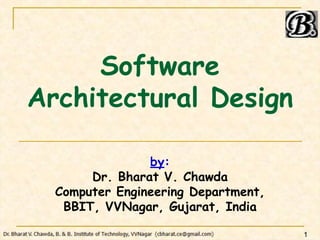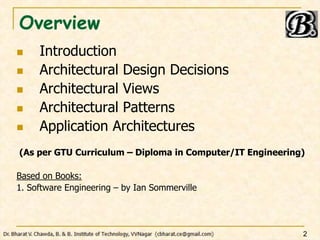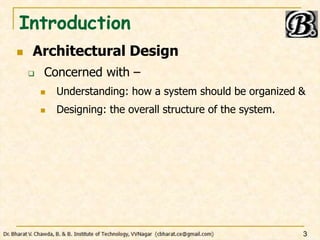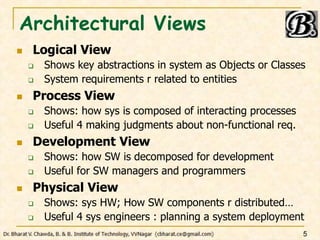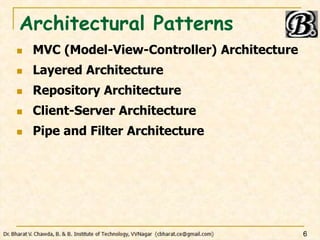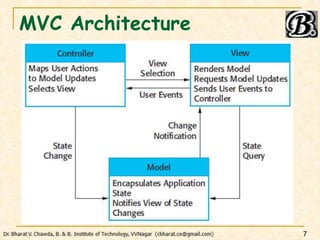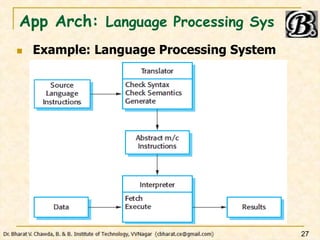SE2023 0207 Software Architectural Design.pptx
- 1. Software Architectural Design by: Dr. Bharat V. Chawda Computer Engineering Department, BBIT, VVNagar, Gujarat, India 1
- 2. Overview ’ü« Introduction ’ü« Architectural Design Decisions ’ü« Architectural Views ’ü« Architectural Patterns ’ü« Application Architectures (As per GTU Curriculum ŌĆō Diploma in Computer/IT Engineering) Based on Books: 1. Software Engineering ŌĆō by Ian Sommerville 2
- 3. Introduction ’ü« Architectural Design ’ü▒ Concerned with ŌĆō ’ü« Understanding: how a system should be organized & ’ü« Designing: the overall structure of the system. 3
- 4. Architectural Design Decisions ’ü« Some fundamental questionsŌĆ” ’ü▒ Is Generic application architecture available? ’ü▒ What is the fundamental approach to structure system? ’ü▒ What architectural patterns or styles might be used? ’ü▒ Which architecture is best: Non-fun requirements? ’ü▒ How: system is distributed across cores & processors? ’ü▒ How: Structural components ’āĀ sub-components? ’ü▒ What Strategy will be used to control op of components? ’ü▒ How architectural design will be evaluated? ’ü▒ How sys architecture will be documented? 4
- 5. Architectural Views ’ü« Logical View ’ü▒ Shows key abstractions in system as Objects or Classes ’ü▒ System requirements r related to entities ’ü« Process View ’ü▒ Shows: how sys is composed of interacting processes ’ü▒ Useful 4 making judgments about non-functional req. ’ü« Development View ’ü▒ Shows: how SW is decomposed for development ’ü▒ Useful for SW managers and programmers ’ü« Physical View ’ü▒ Shows: sys HW; How SW components r distributedŌĆ” ’ü▒ Useful 4 sys engineers : planning a system deployment 5
- 6. Architectural Patterns ’ü« MVC (Model-View-Controller) Architecture ’ü« Layered Architecture ’ü« Repository Architecture ’ü« Client-Server Architecture ’ü« Pipe and Filter Architecture 6
- 9. MVC Architecture: Concept ’ü« Concept ’ü▒ Separates presentation and interaction from sys data ’ü▒ Model: Manages system data & associated operations ’ü▒ View: Manages how data is presented to the user ’ü▒ Controller: Manages user interactions; passes to M, V ’ü« When used ’ü▒ There are multiple ways to view & interact with data ’ü▒ Future requirements for interaction and presentation of data are unknown 9
- 10. MVC Architecture: Ad-Disad ’ü« Advantage ’ü▒ Allows data to change independently of its representation and vice versa ’ü▒ Supports presentation of the same data in different ways ’ü« Disadvantage ’ü▒ Can involve additional code and code complexity: when data model and interactions are simple 10
- 12. Layered Architecture: Example ’ü« Library System 12
- 13. Layered Architecture: Concept ’ü« Concept ’ü▒ Organizes the system into layers: Each layer has some functionality ’ü▒ A layer provides services to the layer above it ’ü▒ Lowest-level layers provide core services: likely to be used throughout the system ’ü« When used ’ü▒ Building new facilities on top of existing systems ’ü▒ Development is spread across several teamsŌĆ” ’ü▒ Requirement for multi-level security 13
- 14. Layered Architecture: Ad-Disad ’ü« Advantage ’ü▒ Allows replacement of entire layer without affecting system ’ü▒ Redundant facilities can be provided in each layer to increase dependability; Ex: Authentication ’ü« Disadvantage ’ü▒ Providing clean separation between layers is difficult ’ü▒ Service request is processed at each layer ’āĀ May affect the performance 14
- 15. Repository Architecture: Ex ’ü« IDE 15
- 16. Repository Architecture: Concept ’ü« Concept ’ü▒ All data in a system is managed in a central database (repository) : accessible to all components ’ü▒ Components do not interact directly; but through repository ’ü« When used ’ü▒ Systems having large volumes of data/info : need to be stored for a long time 16
- 17. Repository Architecture: Ad-Disad ’ü« Advantage ’ü▒ Components can be independent ŌĆō do not need to know existence of other components ’ü▒ Consistent data management ’ü▒ Changes made by one component can be propagated to all components ’ü« Disadvantage ’ü▒ Repository is a single point of failure ’ü▒ Distributing repository across several computers may be difficult 17
- 18. Client-Server Architecture: Ex ’ü« Film/Video Library 18
- 19. Client-Server Arch: Concept ’ü« Concept ’ü▒ Functionality of the system is organized into services: each service delivered from a separate server ’ü▒ Clients are users of these services; Access servers to make use of them ’ü« When used ’ü▒ Data in shared database need to be accessed from a range of locations ’ü▒ Load on a system is variable: As servers can be replicated 19
- 20. Client-Server Arch: Ad-Disad ’ü« Advantage ’ü▒ Servers can be distributed across a network ’ü▒ General functionality can be available to all clients: No need to be implemented by all services: Ex ŌĆō Printing Service ’ü« Disadvantage ’ü▒ Each service is a single point of failure: Denial of Service; Server Failure ’ü▒ Unpredictable performance: depends upon network + system ’ü▒ Management prob possible: servers r owned by diff org 20
- 21. Pipe & Filter Architecture: Ex ’ü« Invoice Management 21
- 22. Pipe n Filter Arch: Concept ’ü« Concept ’ü▒ Processing of data : Set of components ’āĀ Filters ’ü▒ Filters: discrete, transforms data ’ü▒ Data flows from one component to another as in pipes ’ü« When used ’ü▒ In data processing applications : Inputs are processed in separate stages to generate related outputs ’ü▒ Ex: Batch processing, Transaction-based processing 22
- 23. Pipe n Filter Arch: Ad-Disad ’ü« Advantage ’ü▒ Easy to understand; Supports transformation reuse ’ü▒ Evolution by adding transformations is straight forward ’ü▒ Can be implemented: Sequential or Concurrent ’ü« Disadvantage ’ü▒ Data need to be parsed or unparsed as per format of different components ’ü▒ This increases system overhead ’ü▒ Transformation canŌĆÖt be reused if uses incompatible data structures 23
- 24. Application Architectures ’ü« What? ’ü« Applications ŌĆō ’ü▒ As a starting point for the architectural design process ’ü▒ As a design check list ’ü▒ As a way of organizing the work of the development team ’ü▒ As a means for assessing components for reuse ’ü▒ As a vocabulary for talking about types of applications 24
- 25. App Arch: Transaction Processing Sys ’ü« Example: ATM System 25
- 26. App Arch: Information Systems ’ü« Example: Hospital System 26
- 27. App Arch: Language Processing Sys ’ü« Example: Language Processing System 27
- 28. Thank-UŌĆ”!!! 28

